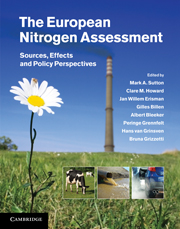Book contents
- Frontmatter
- Contents
- List of contributors
- Foreword
- Summary for policy makers
- Technical summary
- 1 Assessing our nitrogen inheritance
- Part I Nitrogen in Europe: the present position
- Part II Nitrogen processing in the biosphere
- 6 Nitrogen processes in terrestrial ecosystems
- 7 Nitrogen processes in aquatic ecosystems
- 8 Nitrogen processes in coastal and marine ecosystems
- 9 Nitrogen processes in the atmosphere
- Part III Nitrogen flows and fate at multiple spatial scales
- Part IV Managing nitrogen in relation to key societal threats
- Part V European nitrogen policies and future challenges
- Glossary
- Index
- References
7 - Nitrogen processes in aquatic ecosystems
from Part II - Nitrogen processing in the biosphere
Published online by Cambridge University Press: 16 May 2011
- Frontmatter
- Contents
- List of contributors
- Foreword
- Summary for policy makers
- Technical summary
- 1 Assessing our nitrogen inheritance
- Part I Nitrogen in Europe: the present position
- Part II Nitrogen processing in the biosphere
- 6 Nitrogen processes in terrestrial ecosystems
- 7 Nitrogen processes in aquatic ecosystems
- 8 Nitrogen processes in coastal and marine ecosystems
- 9 Nitrogen processes in the atmosphere
- Part III Nitrogen flows and fate at multiple spatial scales
- Part IV Managing nitrogen in relation to key societal threats
- Part V European nitrogen policies and future challenges
- Glossary
- Index
- References
Summary
Executive summary
Nature of the problem
Freshwater ecosystems play a key role in the European nitrogen (N) cycle, both as a reactive agent that transfers, stores and processes N loadings from the atmosphere and terrestrial ecosystems, and as a natural environment severely impacted by the increase of these loadings.
Approaches
This chapter is a review of major processes and factors controlling N transport and transformations for running waters, standing waters, groundwaters and riparian wetlands.
Key findings/state of knowledge
The major factor controlling N processes in freshwater ecosystems is the residence time of water, which varies widely both in space and in time, and which is sensitive to changes in climate, land use and management.
The effects of increased N loadings to European freshwaters include acidification in semi-natural environments, and eutrophication in more disturbed ecosystems, with associated loss of biodiversity in both cases.
An important part of the nitrogen transferred by surface waters is in the form of organic N, as dissolved organic N (DON) and particulate organic N (PON). This part is dominant in semi-natural catchments throughout Europe and remains a significant component of the total N load even in nitrate enriched rivers.
In eutrophicated standing freshwaters N can be a factor limiting or co-limiting biological production, and control of both N and phosphorus (P) loading is often needed in impacted areas, if ecological quality is to be restored.
- Type
- Chapter
- Information
- The European Nitrogen AssessmentSources, Effects and Policy Perspectives, pp. 126 - 146Publisher: Cambridge University PressPrint publication year: 2011
References
- 47
- Cited by

